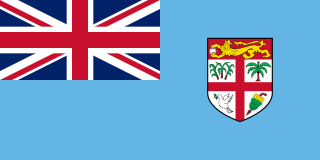
Fiji, officially the Republic of Fiji, is an island country in Melanesia, part of Oceania in the South Pacific Ocean. It lies about 1,100 nautical miles north-northeast of New Zealand. Fiji consists of an archipelago of more than 330 islands—of which about 110 are permanently inhabited—and more than 500 islets, amounting to a total land area of about 18,300 square kilometres (7,100 sq mi). The most outlying island group is Ono-i-Lau. About 87% of the total population of 924,610 live on the two major islands, Viti Levu and Vanua Levu. About three-quarters of Fijians live on Viti Levu's coasts, either in the capital city of Suva, or in smaller urban centres such as Nadi or Lautoka. The interior of Viti Levu is sparsely inhabited because of its terrain.

The underworld, also known as the netherworld, is the supernatural world of the dead in various religious traditions and myths, located below the world of the living. Chthonic is the technical adjective for things of the underworld.

The Indian brown mongoose or brown mongoose is a mongoose species native to the Western Ghats in India and the western coast in Sri Lanka and introduced to Fiji. It is listed as least concern on the IUCN Red List.
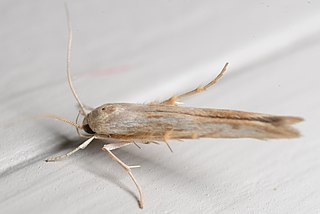
Stathmopoda aposema is a species of moth of the family Stathmopodidae. The common name is Kowhai Seed Moth. It is found in New Zealand.

Stathmopoda melanochra is a species of moth of the family Stathmopodidae. It is found in Australia and New Zealand.

Stathmopoda is a genus of moths. It has variously been placed in its own family, Stathmopodidae, or in subfamily Stathmopodinae in the family Oecophoridae. Note that the phylogeny and systematics of gelechoid moths are still not fully resolved.

Stathmopoda auriferella is a species of moth in the Stathmopodidae family. It is found in the Oriental and Afrotropical regions. In the Palearctic it is only found in subtropical areas such as the Middle East and the Russian Far East.

Stathmopoda aconias is a species of moth of the family Stathmopodidae. It is found in India and Sri Lanka.

Stathmopoda campylocha is a species of moth in the family Stathmopodidae. It is endemic to New Zealand. It is classified as critically endangered by the Department of Conservation.
Stathmopoda endotherma is a species of moth in the family Stathmopodidae. It is endemic to New Zealand. It is classified as "At Risk, Naturally Uncommon" by the Department of Conservation.

Stathmopoda holochra is a moth of the family Stathmopodidae. It was described by Edward Meyrick in 1889 using specimens first collected at the Wellington Botanic Garden. It is endemic to New Zealand. The larvae of this species feed on Phormium seed heads.

Stathmopoda skelloni, the yellow featherfoot, is a species of moth in the Stathmopodidae family. It is endemic to New Zealand and can be found throughout the country. This species inhabits native forest, coastal dunes and shrubland as well as cultivated gardens and orchards. The larvae of this species feed on a variety of plant species including agricultural crops such as kiwifruit and persimmons. The adult moths are on the wing from September until March and are nocturnal but are attracted to light.

Stathmopoda mysteriastis is a moth of the family Stathmopodidae. It was described by Edward Meyrick in 1901. It is found in New Zealand.

Stathmopodidae is a family of moths in the moth superfamily Gelechioidea described by Edward Meyrick in 1913.
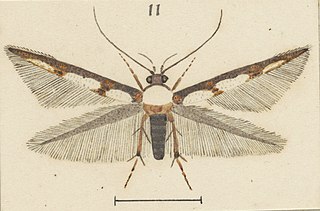
Stathmopoda aristodoxa is a species of moth in the family Stathmopodidae. It is endemic to New Zealand. It is classified as "At Risk, Naturally Uncommon" by the Department of Conservation.
Stathmopoda masinissa, the persimmon fruit moth, is a moth of the family Stathmopodidae. The species was first described by Edward Meyrick in 1906. It is a serious pest on several persimmon species. It is found in several Old World countries Japan, Korea, Australia, Sri Lanka, Thailand and China.
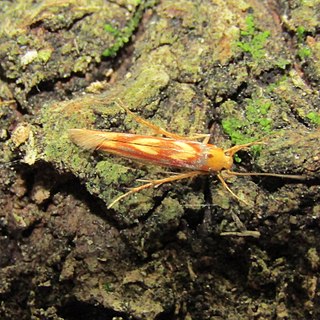
Stathmopoda caminora is a species of moth in the family Stathmopodidae. It was first described by Edward Meyrick in 1890 and is endemic to New Zealand.

Stathmopoda distincta is a moth of the family Stathmopodidae. It was described by Alfred Philpott in 1923. It is endemic to New Zealand.
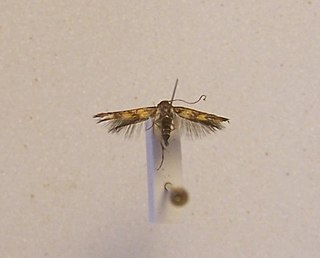
Stathmopoda distincta is a moth of the family Stathmopodidae. It was described by Edward Meyrick in 1926. It is endemic to New Zealand.
Stathmopoda cephalaea is a moth of the family Stathmopodidae. It was described by Edward Meyrick in 1897. It is found in Australia and has been recorded in New Zealand.

















